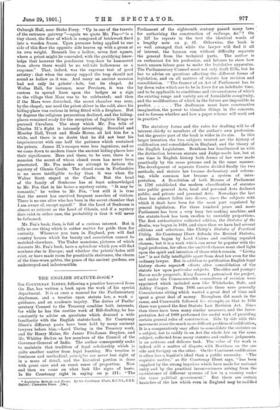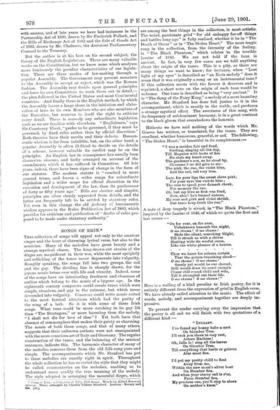THE ENGLISH STATUTE-BOOK.*
SIR COURTENAY ILBERT, following a practice borrowed from the Bar, has written a book upon the work of his special department. It is at once a manual for the Parliamentary draftsman, and a treatise upon statute law, a work o guidance, and an academic inquiry. The duties of Parlia- mentary Counsel to the Treasury combine both interests, for while he has the routine work of Bill-drafting, he has constantly to advise on questions which demand a wide familiarity with the English statute-book. Sir Courtenay llbert's different posts have been held by many eminent lawyers before him,—Lord Thring in the Treasury work, and Sir Henry Maine, Sir James FitzJames Stephen, and Mr. Whitley Stokes as law members of the Council of the Governor-General of India. The author consequently seeks to maintain that ,tradition of legal scholarship which is quite another matter from legal learning. His treatise is luminous and methodical, principles are never lost sight of in a mass of detail, and the historical portion is done with great care and an exact sense of proportion. Now and then we come on what look like signs of haste. Is Sir Courtenay right in saying on p. 211: "The • Legislative Methoila and Forms. By Sir Courtenay Ebert, K.C.S.I., C./.E. Oxford; Clarendon Press. Lies.] Parliament of the eighteenth century passed many laws for authorising the construction of railways, 8r.c."? On p. 127 he repeats in the text the identical words of a lengthy note on p. 61. Otherwise, the book is so well arranged that while the lawyer will find it all of interest, the layman can without difficulty separate the general from the technical parts. The author is an enthusiast for his profession, and labours to show how much unseen labour goes to make the legislative apparatus. The Parliamentary Counsel must not only draft Bills, but he has to advise on questions affecting the different forms of legislation, and on all matters of statute law revision and consolidation. "The framer of an Act of Parliament has to lay down rules which are to be in force for an indefinite time, and to be applicable to conditions and circumstances of which the existing range and variety are of formidable complexity, and the modifications of which in the future are impossible to
predict The draftsman must have constructive imagination, the power to visualise things in the concrete, and to foresee whether and how a paper scheme will work out in practice."
The statutory forms and the rules for drafting will be of interest chiefly to members of the author's own profession. but the greater part of the book is wider in its aim. In this larger intention the two subjects treated are the history of codification and consolidation in England, and the theory of the English Legislature. Bentham has familiarised us with the distinction between statute and Judge-made law, but at one time in English history both forms of law were made practically by the same persons and in the same manner. The development of separate Courts divided finally the two methods, and statute law became declaratory and reform- ing, while common law became a system of inter- pretation. A Resolution of both Houses of Parliament in 1796 established the modern classification of statutes into public general Acts, local and personal Acts declared public, and private and personal Acts. Nowadays the last class has almost fallen into disuse, since the subjects with which it dealt have been for the most part regulated by general legislation. For three hundred years and more Parliament has been a very busy law-making machine, and the statute-book has been swollen to unwieldy proportions. The first authoritative collected edition, the Statutes of the Realm, was begun in 1810, and since then we have had several editions and selections, like Chitty's Statutes of Practical Utility. Sir Courtenay Ilbert defends the Revised Statutes, an edition begun by Lord Cairns and omitting repealed clauses; but it is a work -which can never be popular with the legal profession, for often the omitted clauses must shed light. • upon the spirit and intention of those which remain. "Living law" is not fully intelligible apart from dead law even for the ordinary lawyer. But in addition to publication English legal history shows repeatet efforts after consolidation of the statute law upon particular subjects. The elder and younger Bacon made proposals, King James I. patronised the project, and under the Commonwealth committees of revision were appointed which included men like Whitelocke, Hale, and Ashley Cooper. From 1806 onwards there were generally Commissions sitting which wasted a great deal of time and spent a great deal of money. Brougham did much in the cause, and Cranworth followed Ilia example, so that in 1856 there was passed the first Statute Law Revision Act. Since then there have been many similar measures, and the Inter- pretation Act of 1889 performed the useful work of providing certain general rules of construction. Side by side with this movement arose the much more difficult problem of codification. It is a comparatively easy affair to consolidate the statutes on a subject, but to codify in an Act the whole law on the same. subject, collected from many statutes and endless judgments, is an arduous and delicate task. The value of the work is indeed still a matter of dispute, with Bentham on the one side and Savigny on the other. On the Continent codification is often less a legalist's ideal than a public necessity. "The requisite motive," as Sir Courtenay Ebert says, "has been supplied by the strong impulses which have made for national unity and by the practical inconveniences arising from the co-existence of different systems of law in a country under the same political government." But there are certain branches of the law which even in England may be codified with success, and of late years we have had instances in the Partnership Act of 1890, drawn by Sir Frederick Pollock, and the Bills of Exchange Act of 1882 and the Sale of Goods Act of 1893, drawn by Mr. Chalmers, the Assistant Parliamentary Counsel to the Treasury.
But the author is at his best on his second subject, the theory of the English Legislature. There are many valuable works on the Constitution, but we know none which analyses more luminously the peculiar characteristics of our legisla- tion. There are three modes of law-making through a popular Assembly. The Government may present measures to the Assembly to accept or reject, which was the Roman fashion. The Assembly may decide upon general principles and leave its own Committees to work them out in detail,— the plan followed in the United States and most Continental countries. And finally there is the English method, by which the Assembly leaves a large share in the initiation and elabo- ration of laws to its own Members who are also members of the Executive, but reserves to itself the right to criticise every detail. There is scarcely any subordinate legislation such as we are familiar with elsewhere. "Englishmen," says Sir Courtenay Ilbert, "prefer to be governed, if they must be governed, by fixed rules rather than by official discretion." Both theories have their merits and their defects. Bureau- cratic wisdom is far from infallible, but, on the other hand, a popular Assembly is often ill-fitted to decide on the details of a scheme, however valuable its verdict may be on the winciples. An English law in consequence has usually been discursive, obscure, and badly arranged on account of the amendments which it has suffered in Committee. Of late years, indeed, there have been signs of change in the form of our statutes. The modern statute is "couched in more general terms, and leaves a wider range for subordinate legislation and a wider scope for official discretion in the execution and development of the law, than its predecessor of forty or fifty years ago." Bills are shorter and simpler, principles are often clearly separated from details, and the latter are frequently left to be settled by statutory rules. Yet even in this change the old jealousy of bureaucratic wisdom appears in the Rules Publication Act of 1893, which provides for criticism and publication of "drafts of rules pro- posed to be made under statutory authority."





















































 Previous page
Previous page